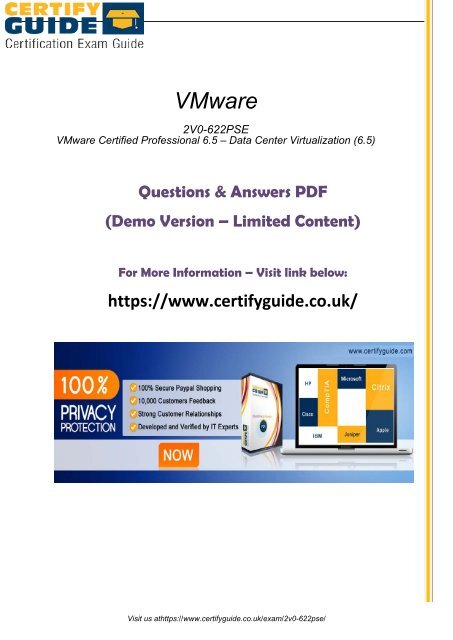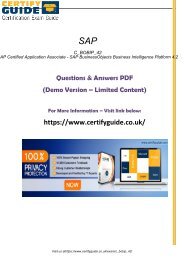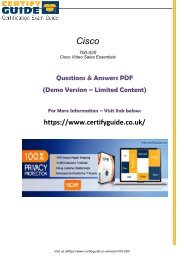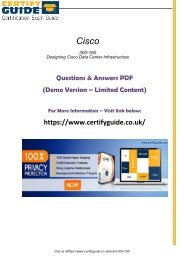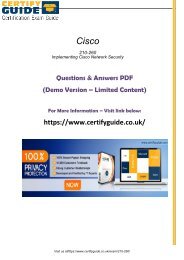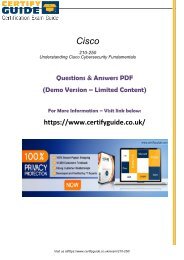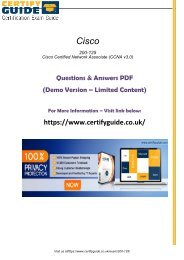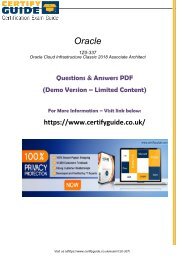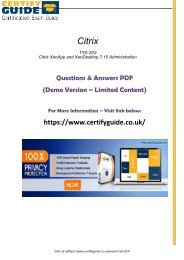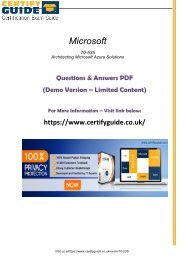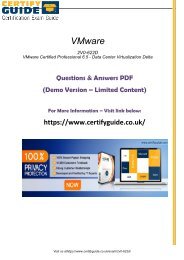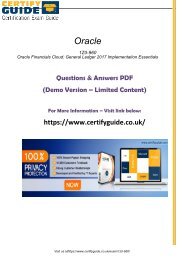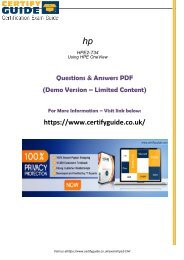2V0-622PSE Exams Study Guides 2018
Why competitors overall put stock in our items? Essentially on the grounds that our items are high caliber and outperform others in greatness, helping competitors carry the coveted outcomes with certainty.Click the link below to get Full Version: https://www.certifyguide.co.uk/exam/2V0-622PSE/
Why competitors overall put stock in our items? Essentially on the grounds that our items are high caliber and outperform others in greatness, helping competitors carry the coveted outcomes with certainty.Click the link below to get Full Version: https://www.certifyguide.co.uk/exam/2V0-622PSE/
Create successful ePaper yourself
Turn your PDF publications into a flip-book with our unique Google optimized e-Paper software.
VMware<br />
<strong>2V0</strong>-<strong>622PSE</strong><br />
VMware Certified Professional 6.5 – Data Center Virtualization (6.5)<br />
Questions & Answers PDF<br />
(Demo Version – Limited Content)<br />
For More Information – Visit link below:<br />
https://www.certifyguide.co.uk/<br />
Visit us athttps://www.certifyguide.co.uk/exam/2v0-622pse/
Question: 1<br />
When using DPM in a vSphere HA cluster with Admission Control enabled, which two statements are<br />
true? (Choose two.)<br />
A. DPM cannot be enabled on a cluster with HA Admission control enabled.<br />
B. If necessary, DPM powers on hosts from standby mode to maintain failover needs.<br />
C. EVC must be enabled on the cluster before DPM can be enabled.<br />
D. DPM and HA do not interact with each other. There will be no change in behavior when DPM is<br />
enabled on a cluster using HA.<br />
E. DPM does not place hosts in standby mode if doing so would violate failover requirements.<br />
Question: 2<br />
Answer: B,E<br />
Which external backup target can be used for vSphere Data Protection 6.1?<br />
A. NetApp Metro Cluster<br />
B. Dell EMC Data Domain<br />
C. IBM SVC<br />
D. Hitachi USP VM<br />
Question: 3<br />
Answer: B<br />
Which are the three supported backup types for the vCenter Server Appliance 6.5? (Choose three.)<br />
A. File-Based Backup<br />
B. vSphere Storage APIs-Data Protection<br />
C. Replication<br />
D. Snapshots<br />
E. vSphere Data Protection<br />
Question: 4<br />
Answer: A,B,E<br />
Which feature is available for a virtual machine configured with DirectPath I/O?<br />
Visit us athttps://www.certifyguide.co.uk/exam/2v0-622pse/
A. DRS<br />
B. Snapshots<br />
C. Fault Tolerance<br />
D. Clone<br />
Answer: D<br />
Explanation:<br />
The following features are unavailable for virtual machines configured with DirectPath:<br />
Question: 5<br />
A vSphere administrator upgraded vCenter Server (VC) from version 5.5 to 6.5. Existing VMFS5<br />
datastores consumption is 75% full. All of the ESXi hosts have been upgraded to version 6.5. Existing<br />
datastores have not yet been upgraded.<br />
Which is VMware’s recommended approach to upgrading each VMFS5 datastore to VMFS6?<br />
A. The option to upgrade datastores to VMFS6 is only available during the ESXi host upgrade process.<br />
B. Log on one ESXi host at a time using vSphere 6.5 Windows Client. Navigate to the datastores view.<br />
Right-click on the VMFS5 datastore, and then select upgrade to VMFS6.<br />
C. Log on to VC using vSphere 6.5 Web Client. Navigate to the datastores view. Right-click on the VMFS5<br />
datastore, and then select upgrade to VMFS6.<br />
D. Log on to VC using vSphere 6.5 Web Client. Create a VMFS6 datastore on a new LUN. Use storage<br />
vMotion to migrate the data to the new datastore.<br />
Answer: D<br />
Explanation:<br />
Perform version check for the vCenter Server and all ESX hosts.<br />
Note: All ESXi hosts and vCenter Server must be of vSphere 6.5. Do not proceed if any one of ESXi hosts<br />
is not vSphere 6.5. Proceeding further means business continuity loss and the new datastore is not<br />
visible in old ESX hosts.<br />
Perform all pre checks for free space availability on datastore DS-2. Available space on DS-2 must be<br />
equal or more than the datastore DS-1 space.<br />
Ensure that the datastore DS-2 is VMFS 6 type.<br />
Prepare list of all virtual machines in the vCenter Server’s inventory that are hosted on datastore DS-1.<br />
Evacuate the datastore DS-1. For this, migrate all the virtual machines running from datastore DS-1 to<br />
datastore DS-2. Storage vMotion operations are performed on these virtual machines.<br />
Perform one migration at a time to avoid disrupting the performance of remaining datacenter entities.<br />
Keep track of any migration failures, if any, re-trigger the migration for those virtual machines.<br />
Ensure that datastore DS-1 is empty by listing files on this datastore.<br />
Note: Proceed further only if datastore DS-1 is empty.<br />
Unmount datastore DS-1 from all ESX hosts.<br />
Delete datastore DS-1.<br />
Visit us athttps://www.certifyguide.co.uk/exam/2v0-622pse/
Create a new datastore with the VMFS 6 filesystem using the same lun. For example, DS-1.<br />
Trigger a storage rescan operation on all hosts and wait for few minutes for this operation to complete.<br />
Move all virtual machines back to datastore DS-1 from datastore DS-2 by performing storage vMotion<br />
operation. It is suggested to migrate one virtual machine at a time. Keep track of any migration failures,<br />
if any, re-trigger migration for those virtual machines.<br />
Question: 6<br />
An administrator has an application that requires high CPU throughput.<br />
Which action would ensure that the application gets the required throughput?<br />
A. Enable Fault Tolerance on the virtual machine.<br />
B. Disable Fully Automated DRS.<br />
C. Set a CPU limit on the virtual machine.<br />
D. Adjust the virtual machine latency sensitivity.<br />
Answer: D<br />
Explanation:<br />
You can adjust the latency sensitivity of a virtual machine to optimize the scheduling delay for latency<br />
sensitive applications.<br />
ESXi is optimized to deliver high throughput. You can optimize your virtual machine to meet the low<br />
latency requirement of latency sensitive applications. Examples of latency sensitive applications are<br />
VOIP or media player applications, or applications that require frequent access to the mouse or<br />
keyboard devices.<br />
Question: 7<br />
Which do Protocol Endpoints refer to?<br />
A. a VASA provider<br />
B. a pool of raw storage capacity that spans different physical arrays<br />
C. a Virtual Volumes datastore<br />
D. a logical I/O proxy of the physical storage fabric<br />
Question: 8<br />
Answer: D<br />
An administrator is trying to remove a host from a vSphere Distributed Switch named DSwitch01. The<br />
following error message is displayed:<br />
vDS DSwitch01 port 17 is still on host 192.168.100.23 connected to VM01 nic=4000 type=vmVnic<br />
Visit us athttps://www.certifyguide.co.uk/exam/2v0-622pse/
Which two actions can the administrator make before removing the host from the vSphere Distributed<br />
Switch? (Choose two.)<br />
A. Migrate VM01 to DSwitch01 port 1.<br />
B. Add an additional vNIC to VM01 to another vSphere Distributed Switch.<br />
C. Migrate VM01 to another host.<br />
D. Disconnect the VM01’s vNIC.<br />
E. Place VM01 into Maintenance Mode.<br />
Answer: C,D<br />
Explanation:<br />
Before removing the host from distributed switch, migrate VM01 to Dswitch01 Port1. Then disconnect<br />
VM01 NIC.<br />
Question: 9<br />
When moving a virtual machine’s virtual disks from Datastore Cluster A to Datastore Cluster B, which<br />
two options should be considered? (Choose two.)<br />
A. Any Inter-VM or Intra-VM Anti-Affinity rules that existed for the virtual disks in Datastore Cluster A<br />
will not be carried over into the new Datastore Cluster.<br />
B. The virtual machine’s virtual disks will be placed by default onto the same datastore within Datastore<br />
Cluster B.<br />
C. If the virtual machine’s virtual disks have anti-affinity rules in Datastore Cluster A, they must be<br />
deleted before the virtual disks can be moved into Datastore Cluster B.<br />
D. The virtual machine needs to be powered off before moving its virtual disks from Datastore Cluster A<br />
to Datastore Cluster B.<br />
E. Any Inter-VM or Intra-VM Anti-Affinity rules that existed for the virtual disks in Datastore Cluster A<br />
will stay with the virtual disks once they have moved to Datastore Cluster B.<br />
Question: 10<br />
Answer: A,B<br />
In order to use vCenter Converter Standalone to convert a Windows 8 physical machine to a virtual<br />
machine, which statement is true?<br />
A. Volume layout can be reorganized on the destination virtual machine as long as the physical machine<br />
is powered off.<br />
B. The physical machine cannot be converted because vCenter Converter Standalone does not support<br />
Windows 8 machines.<br />
C. Volumes can be resized on the destination virtual machine as long as the physical machine is powered<br />
on.<br />
Visit us athttps://www.certifyguide.co.uk/exam/2v0-622pse/
D. The destination virtual machine can be created as a linked clone.<br />
Answer: C<br />
Question: 11<br />
Option available to enable Encrypted vMotion. (Choose two.)<br />
A. Enable<br />
B. Opportunistic<br />
C. Required<br />
D. Default<br />
Answer: B,C<br />
Question: 12<br />
ESXi 6.5 introduces VMFS6, which supports both 512e and 512n devices.<br />
What three configurations are supported when using these devices? (Choose three.)<br />
A. Hosts with both 512e and 512n devices.<br />
B. Storage vMotion between both 512e and 512n devices.<br />
C. Datastore Extents spanned between both 512e and 512n devices.<br />
D. Storage DRS clusters containing only both 512e and 512n devices.<br />
Answer: A,B,D<br />
Explanation:<br />
VMFS can host both 512e and 512n devices. It also supports storage vMotion between 512e and 512n<br />
devices. In addition to that DRS clusters can contain both 512e and 512n devices at the same time.<br />
Question: 13<br />
Which are two requirements for configuring vCenter HA? (Choose two)<br />
A. A secondary NIC on the active node must be create and configured<br />
B. A management and heartbeat network must be created and configured<br />
C. A default gateway entry must be added for the cluster network<br />
D. All components must be on the same subnet as the management network<br />
E. The network IP addresses for the active, passive, and witness nodes must be static<br />
Visit us athttps://www.certifyguide.co.uk/exam/2v0-622pse/
Answer: B,E<br />
Question: 14<br />
An administrator is upgrading their external Platform Services Controllers and vCenter Server Appliance,<br />
and also migrating vSphere Update Manager version 6.0 to version 6.5.<br />
Which is the correct order to upgrade these components?<br />
A. - Upgrade the external Platform Services Controller- Run the Migration Assistant on the vSphere<br />
Update Manager- Upgrade the vCenter Server Appliance<br />
B. - Upgrade the external Platform Services Controller- Upgrade the vCenter Server Appliance- Run the<br />
Migration Assistant on the vSphere Update Manager<br />
C. - Upgrade the external Platform Services Controller- Upgrade the vSphere Update Manager- Upgrade<br />
the vCenter Server Appliance<br />
D. - Upgrade the vCenter Server Appliance- Run the Migration Assistant on the vSphere Update<br />
Manager- Upgrade the external Platform Services Controller<br />
Question: 15<br />
Answer: A<br />
An Administrator for a new vCenter Server HA deployment has an infrastructure that is using an external<br />
Platform Services Controller (PSC).<br />
Which three Load Balancers are supported by VMware? (Choose three.)<br />
A. Windows network Load Balancer<br />
B. F5 BIG-I<br />
C. VMware NSX EDGE<br />
D. Citrix Netscaler<br />
E. Linux HA Proxy<br />
Question: 16<br />
Answer: B,C,D<br />
Two sibling resource pools named RP-CHILD-A and RP-CHILD-B have these configurations:<br />
• RP-CHILD-A has an expandable reservation and memory shares set to ‘2000’ with 10 VMs, each with<br />
4GB of RAM<br />
• RP-CHILD-B has an expandable reservation and memory shares set to ‘4000’ with 30 VMs, each with<br />
4GB of RAM<br />
Which statement is true during times of memory contention?<br />
Visit us athttps://www.certifyguide.co.uk/exam/2v0-622pse/
A. VMs in RP-CHILD-B will have the same number of shares as in RP-CHILD-A<br />
B. VMs in RP-CHILD-A will not use shares to allocate resources<br />
C. As long as no additional VMs are added to either resource pool, VMs in RP-CHILD-A will ALWAYS have<br />
more shares per VM than RP-CHILD-B<br />
D. As long as no additional VMs are added to either resource pool, VMs in RP-CHILD-B will ALWAYS have<br />
more shares per VM than RP-CHILD-A<br />
Question: 17<br />
Answer: C<br />
In vCenter Server 6.5, Host Customizations within Host Profiles be exported as which two formats?<br />
(Choose two.)<br />
A. .xlsx<br />
B. .csv<br />
C. .ova<br />
D. .xls<br />
E. .vpf<br />
Question: 18<br />
Answer: B,E<br />
An administrator discovers that virtual machine migrations with encrypted vMotion have failed.<br />
Which action can resolve this issue?<br />
A. Use vSphere Update Manager to upgrade all hosts to ESXi 6.5<br />
B. Install a USB decryption dongle on all hosts in the cluster<br />
C. Disable Strict Lockdown mode<br />
D. Use esxcli to enable encrypted vMotion<br />
Question: 19<br />
Answer: A<br />
What is the logical and physical sector size for 512e disks?<br />
A. Logical Sector Size 512 Physical Sector Size 512<br />
B. Logical Sector Size 512 Physical Sector Size 4096<br />
C. Logical Sector Size 4096 Physical Sector Size 4096<br />
D. Logical Sector Size 2048 Physical Sector Size 512<br />
Visit us athttps://www.certifyguide.co.uk/exam/2v0-622pse/
Answer: B<br />
Question: 20<br />
What are limits of vCenter Libraries in vSphere 6.5?<br />
A. Total items 2000, Biggest item size 1TB, total libraries per VC 1000, total items per library 1000 and<br />
max number of syncs 16<br />
B. Total items 4000, Biggest item size 512TB, total libraries per VC 2000, total items per library 2000 and<br />
max number of syncs 24<br />
C. Total items 1000, Biggest item size 1TB, total libraries per VC 1000, total items per library 1000 and<br />
max number of syncs 16<br />
D. Total items 2000, Biggest item size 1TB, total libraries per VC 1000, total items per library 1000 and<br />
max number of syncs 32<br />
Answer: A<br />
Visit us athttps://www.certifyguide.co.uk/exam/2v0-622pse/
Powered by TCPDF (www.tcpdf.org)<br />
For More Information – Visit link below:<br />
https://www.certifyguide.co.uk/<br />
Thanks for Using Our Product<br />
Use coupon code “20off<strong>2018</strong>” for 20% discount<br />
Visit us athttps://www.certifyguide.co.uk/exam/2v0-622pse/


